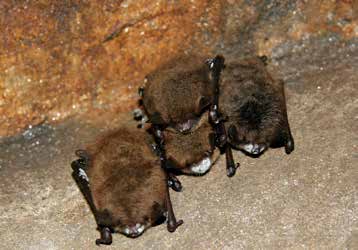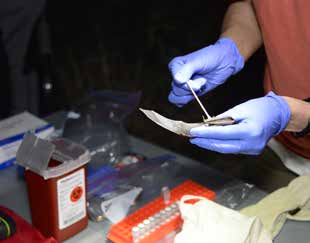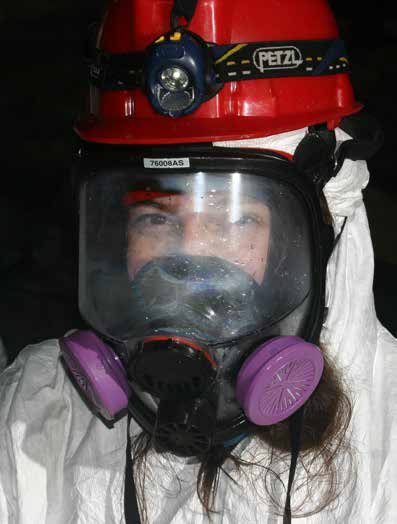By Marianne Moore, Ph.D., Arizona State University assistant professor Originally published in the Fall 2017 Edition of Mountain Lines Around Valentine’s Day 2007, a phone call from the New York State Department of Environmental Conservation to my Ph.D. advisor at Boston University, Dr. Tom Kunz, alerted us to unusual bat mortality occurring in New York hibernacula (caves and mines where bats roost during winter). Soon after, I was donned in a Tyvec suit, double layers of nitrile gloves, a full face mask, and duct tape to secure all openings. After getting properly protected, I was sent to rappel along an ice sheet into a seemingly bottomless pit leading to darkness and dying bats. The deaths we investigated underground were the result of a newly introduced bat fungal disease now called white-nose syndrome (WNS) that has, at the most recent estimates, killed more than seven million North American bats. If you live in or visit the east, you may recognize the effects of WNS by observing how few bats are in the evening sky, a time of day when there would normally be a plenitude of silhouetted bats performing aerial acrobatics while voraciously foraging for insects. The emergence of WNS redirected the focus of my research, drastically altered how agencies and researchers approach conserving North American bats, and most crucially, imperiled multiple species of bat with heightened risks of extinction. What we now know about WNS is that the culprit is a newly described fungus, Pseudogymnoascus destructans, most likely transported to North America from Europe. We understand the WNS fungus grows optimally at cold and humid conditions used by bats during hibernation. Some, but not all, infected bats develop white fuzzy noses from characteristic and exuberant fungal growth at these conditions. Infection, which occurs through the skin, is established only during hibernation, a time when many physiological processes are naturally reduced in bats to conserve energy. (Bats generally do not eat during hibernation.) Infection can lead to disruptions in behavior, rapid exhaustion of stored fat, and emaciation. We understand that WNS is associated with extensive damage to the wings of bats, necessary for locomotion, and important for homeostasis (the state of maintaining stable conditions necessary for survival). We also know that not all bats are equally susceptible to WNS. Some species are reduced to roughly four percent of their pre-WNS population size. Other species are resistant and apparently thriving. But, the geographic spread of the disease has been disturbingly rapid. As of this writing, WNS has been confirmed in 31 states and five Canadian provinces. At-risk are more than half of the 47 bat species living in the United States and Canada. Humans are not affected. Massive efforts aimed at understanding and managing WNS are underway, guided by a National Plan issued by the United States Fish and Wildlife Service in 2011. Many caves and mines have been closed, and detailed decontamination protocols are being used to minimize the spread of the disease by humans. The good news is that there are survivors! Even in the most heavily impacted species, some bats appear to clear the infection and survive. Many research efforts are focused on what explains survival in these bats, and how this information may be used to protect other populations. There is a credible threat to Arizona bats. Of the 28 species of bat in Arizona, roughly half are known hibernators. In spring 2017, the WNS fungus was found on two species sampled in Texas, but with ranges including Arizona. We do not know when WNS will arrive in Arizona or how it will impact western bat species. Since Dixie Mine may serve as an early indicator site for the arrival of WNS in our state, the Conservancy’s bat monitoring project is now more important than ever.





